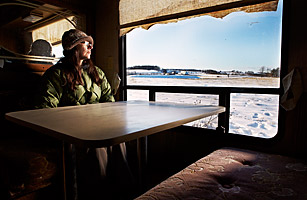
For more than a decade, Bonnie Burnett and her husband Truman have owned
a second home in the hilly farmland of Bradford County, in northeastern
Pennsylvania. It was a getaway for the Burnetts , a place to take their grandchildren for a
swim in the wooded pond that lies just a few steps from their front
door. “It used to be heaven here,” says Bonnie. “We were going to move
here to live.”
The Burnetts say their plans changed when a natural gas drilling
operation on an adjacent property started less than 400 ft. from
their house. It was one of thousands of wells that have been drilled in
Pennsylvania as part of a booming natural gas rush. In June 2009, when
the Burnetts were home in Stroudsburg, tens of thousands of gallons of
drilling water that had been stored on the well pad spilled, leaking
downhill and into the Burnetts’ trees and pond. Truman says that spill
ruined a 50-ft. swath of forest and affected their water. The
pond seems lifeless, and the bass and perch that the Burnetts once
fished with their grandchildren are gone. Even after the accident, the
well is still running. The Burnetts can hear the hum of a gas compressor
running 24 hours a day. “Did it ruin my life?” asks a tearful Bonnie.
“I’d have to say yes.” Dave DeCristo of nearby Canton, Pa., can see wells from his home too,
but that’s where any similarity with the Burnetts ends. DeCristo moved
to this rural community to work as a plumber before he launched a gas
station and a fuel-support outfit. He did well, but his businesses
really took off in 2008, when drilling companies eager for the region’s
natural gas began setting up shop, and he’s added dozens of employees.
In addition, DeCristo — like other landowners around the region —has sold a gas company the right to drill on his land. There’s a well
not far from his front door. “I could never dream I was going to be able
to grow this big,” he says. “I’ve been a blessed person because of
this.”
Until recently, natural gas was the forgotten stepsister of fuels. It
provides about a quarter of U.S. electricity and heats over 60 million
American homes, but it’s always been limited — more expensive than
dirty coal, dirtier than nuclear or renewables. Much of Europe depends
on gas for heating and some electricity — but the bulk of the supply
comes from Russia, which hasn’t hesitated to use energy as a form of
political blackmail. The fuels of the future were going to be solar,
wind and nuclear. “The history of natural gas in the U.S. has been a
roller-coaster ride,” says Tony Meggs, a co-chair of a 2010
Massachusetts Institute of Technology gas study. “It’s been up and down
and up and down.”